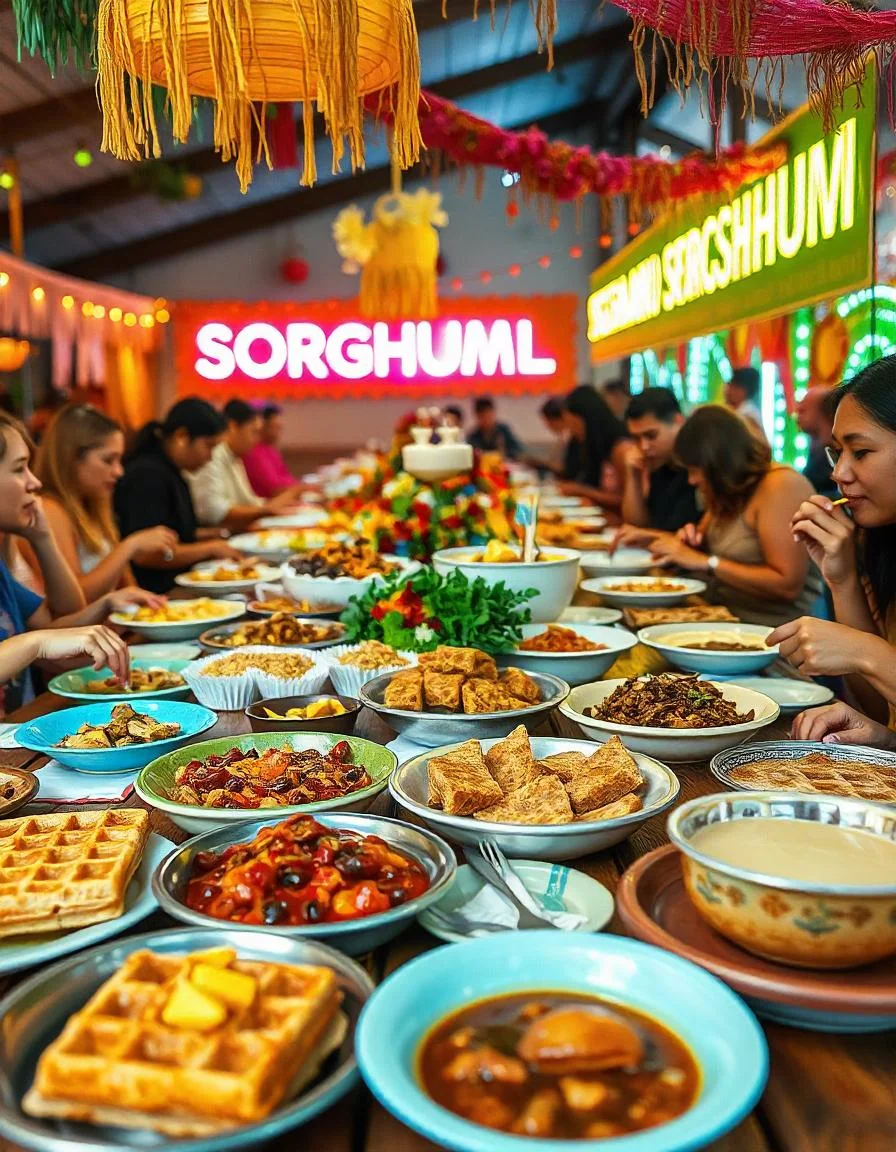Sorghum festival food has a rich cultural significance, offering a taste of tradition while showcasing the versatility and health benefits of this ancient grain. From savory dishes to sweet treats, sorghum is a star ingredient at festivals around the world. In this article, we’ll dive into the diverse ways sorghum is celebrated, explore its health benefits, and give you a glimpse into the cultural importance of sorghum festival food.
Why Sorghum Festival Food is Essential in Festivals
Sorghum is not just a nutritious grain; it plays a vital role in cultural celebrations. Throughout history, this ancient grain has been used to create festive dishes that bring people together, creating a unique link between food and culture.
In various parts of the world, sorghum is more than just food. It’s a symbol of prosperity, a part of rituals, and a bridge that connects generations. In sorghum festivals, chefs, farmers, and home cooks alike celebrate the grain’s versatility by preparing a variety of dishes that highlight its texture and flavor.
The Health Benefits of Sorghum Festival Food
One of the reasons sorghum festival food has gained popularity is due to its remarkable health benefits. Sorghum is a powerhouse of nutrition, offering fiber, protein, and essential minerals like magnesium, iron, and potassium. It’s also gluten-free, making it an excellent choice for those with gluten sensitivities or celiac disease.
Rich in Fiber and Protein
Sorghum contains a high amount of dietary fiber, which helps in digestion and promotes heart health. The protein content in sorghum is also impressive, making it a great alternative for vegetarians and vegans looking for plant-based protein sources.
Packed with Antioxidants
Sorghum is loaded with antioxidants, which help combat inflammation and reduce the risk of chronic diseases such as heart disease and diabetes. The presence of phenolic compounds in sorghum makes it a strong contender for promoting overall well-being.
A Low Glycemic Option
Unlike many grains, sorghum has a low glycemic index, meaning it won’t cause a rapid spike in blood sugar. This makes sorghum festival food an ideal option for those managing blood sugar levels, such as individuals with diabetes.
Top Sorghum Festival Food to Try
Sorghum festival food is diverse and can be enjoyed by everyone, regardless of dietary preferences. Here are some of the most popular dishes that are often featured at sorghum festivals.
1. Sorghum Waffles with Syrup
Sorghum waffles are a festival favorite. These waffles are made with sorghum flour, which gives them a dense, nutty flavor. When paired with sorghum syrup—similar to molasses in taste—this dish becomes a true festival treat. Sorghum syrup is packed with antioxidants and gives these waffles a rich, deep sweetness that pairs perfectly with fresh fruit or whipped cream.
2. Sorghum Chili
For those who prefer savory dishes, sorghum chili is a must-try. This hearty dish uses sorghum grains in place of beans or meat, making it a plant-based, gluten-free, and protein-packed meal. The grains absorb the spices and flavors of the chili, resulting in a rich, satisfying texture. Perfect for warming up on a cool festival day, sorghum chili is a healthy alternative to traditional chili.
3. Sorghum Flour Pancakes
For breakfast or dessert, sorghum flour pancakes are a delightful option. These pancakes are naturally gluten-free and offer a slightly nutty flavor. When served with bananas, berries, or a drizzle of sorghum syrup, they provide a healthy yet indulgent start to your day. These pancakes highlight why sorghum festival food is so beloved—it’s both nutritious and delicious.
4. Sorghum Granola Bars
Sorghum granola bars are the perfect on-the-go snack. Packed with sorghum flakes, nuts, and a bit of honey or dark chocolate, these bars are ideal for festival-goers needing an energy boost. These bars are a tasty and healthy snack that balances sweetness with nutritional value.
5. Sorghum Porridge
For a comforting breakfast, sorghum porridge is a classic. Made by cooking sorghum grains in water or milk, this dish is enriched with cinnamon, a touch of sorghum syrup, and your favorite nuts or dried fruit. It’s a warming and wholesome way to start the day, especially during cooler festival seasons.
How Sorghum Festival Food is Made: Cooking Tips and Tricks
If you want to bring the flavors of sorghum festival food into your own kitchen, here are some helpful tips to make the cooking process easy and fun.
Soaking Sorghum Grains
Soaking whole sorghum grains overnight before cooking can reduce their cooking time and improve their texture. This simple step will help you achieve a softer, more pleasant texture in your dishes.
Using Sorghum Flour
Sorghum flour is a fantastic gluten-free option for baking. It’s best to combine it with other gluten-free flours, like rice or almond flour, to achieve the perfect balance in texture. Sorghum flour is ideal for pancakes, waffles, breads, and other baked goods.
Sorghum Syrup as a Sweetener
Sorghum syrup is a natural sweetener that can be used in both sweet and savory dishes. It’s rich in flavor and packed with antioxidants. Try drizzling it over pancakes, waffles, or using it in marinades for grilled vegetables or meats.
Using Sorghum in Place of Rice or Quinoa
Sorghum can also be a great substitute for rice or quinoa in many dishes. It works particularly well in pilafs, salads, and stews, absorbing flavors from broths and spices beautifully.
Sorghum Festival Food: A Gluten-Free Delight
One of the standout features of sorghum festival food is that it’s naturally gluten-free. This makes it a fantastic choice for those with gluten sensitivities or those who simply prefer to avoid gluten. Sorghum can be used in place of traditional wheat-based grains, ensuring that everyone can enjoy the rich, flavorful dishes at a sorghum festival.
Sorghum’s Role in Rituals and Ceremonies
Beyond its culinary role, sorghum has deep cultural and spiritual significance in many traditions. In some African cultures, sorghum is used in ceremonies and rituals to honor ancestors and seek blessings for the harvest. Similarly, in Native American cultures, sorghum is used in prayer rituals and sacred offerings. These ceremonies highlight sorghum’s symbolic connection to the earth, the community, and the divine.
Sorghum Farming and Global Production
Sorghum is grown all over the world, and it thrives in diverse climates. It’s particularly common in regions like Africa, Asia, and the Americas, where it plays an important role in feeding local populations. In countries like the United States, Nigeria, and India, sorghum is grown in large quantities and used for both food and animal feed.
Conclusion: Embrace Sorghum Festival Food
Sorghum festival food offers a culinary experience that’s rich in tradition, nutrition, and flavor. Whether you’re enjoying a plate of sorghum chili, munching on sorghum granola bars, or savoring sorghum waffles with syrup, this grain proves to be a versatile and valuable addition to your diet. From its historical significance to its health benefits, sorghum festival food connects people across cultures and brings people together around the table.
By exploring sorghum festival food, you not only experience the delicious flavors of this ancient grain but also gain a deeper appreciation for its role in global festivals and its positive impact on health and sustainability. Start experimenting with sorghum in your own kitchen and experience the magic of sorghum festival food today!


